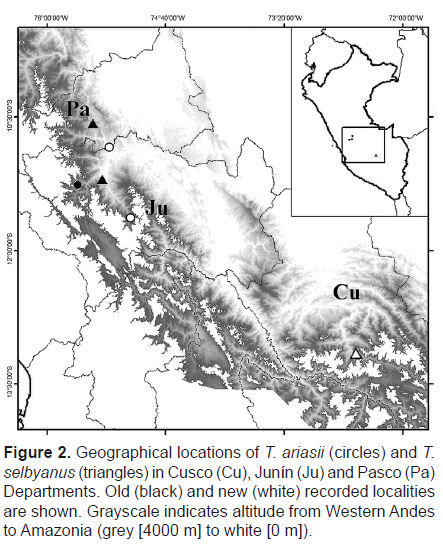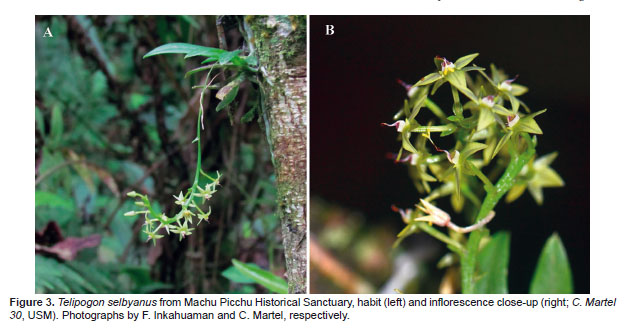Services on Demand
Journal
Article
Indicators
-
 Cited by SciELO
Cited by SciELO
Related links
-
 Similars in
SciELO
Similars in
SciELO  uBio
uBio
Share
Revista Peruana de Biología
On-line version ISSN 1727-9933
Rev. peru biol. vol.23 no.1 Lima Jan./Apr. 2016
http://dx.doi.org/10.15381/rpb.v23i1.11832
doi: http://dx.doi.org/10.15381/rpb.v23i1.11832
TRABAJOS ORIGINALES
New records for two Peruvian endemic Telipogon (Orchidaceae) including an unexpected record of Telipogon ariasii
Nuevos registros para dos Telipogon (Orchidaceae) endémicas peruanas, incluyendo un registro inesperado de Telipogon ariasii
Carlos Martel
1 Institute of Evolutionary Ecology and Conservation Genomics, Ulm University, Helmholtzstr. 10/1 (Containerstadt), Ulm 89081, Germany
E-mail: carlos.martel-gora@uni-ulm.de; ORCID: http://orcid.org/0000-0001-9892-1999
Abstract
The paper registers for first time to Telipogon selbyanus in southern Peru and new records to Telipogon ariasii. A new record of Telipogon ariasii was found surprisingly ca. 2000 m a.s.l. below the type location. Herein I provide taxonomic notes, a distribution map and the updated conservation status of both species.
Keywords: Telipogon; Peru; endemism; distribution; Andes.
Resumen
La nota registra por primera vez a Telipogon selbyanus en el sur de Perú y nuevos registros para Telipogon ariasii. Un nuevo registro de Telipogon ariasii fue encontrado sorprendentemente a 2000 m.s.n.m. por debajo de la localidad tipo. Se proveen notas taxonómicas, un mapa de distribución y una categorización actualizada del estado de conservación de ambas especies.
Palabras clave: Telipogon; Perú; endemismo; distribución; Andes.
Introduction
Species of the genus Telipogon Kunth usually show narrow distributions (Martel & Nauray 2013). Several Telipogon species are solely represented by their type collections and only known from their type locality. Recent field work, explorations and revision of gathered material at diverse herbaria showed that the Peruvian Telipogon diversity is much higher than it is already known (e.g. Collantes & Martel 2015). Peruvian endemic species of Telipogon are of special interest because many are to some degree threatened or endangered (Roque & León 2007), such as Telipogon ariasii Dodson & D.E.Benn. and Telipogon selbyanus N.H.Williams & Dressler. Telipogon ariasii is only known from one locality, Huasahuasi, at high altitude in Western Andes (Dodson & Bennett 1989, Brako & Zarucchi 1993, Roque & León 2007) and until recently it was represented only by the type collection (Bennett 3613; MOL, NY). Whereas T. selbyanus has only been known from central Peru (Bennett & Christenson 1998a, 1998b, Roque & León 2007). Herein I provide new records that increase the distribution limits of these two endemic species and give taxonomic notes for both.
Telipogon ariasii Dodson & D.E.Benn.
Icon. Pl. Trop., ser. 2, 2: t. 184. 1989. Fig. 1
Type: PERU. Junín: [Prov.] Tarma, Huasahuasi, 2800 m, 7 Jun 1986, Bennett 3613 (holotype MO, not found); Huasahuasi, 2850 m, 29 Aug 1987, Bennett 3613 (lectotype MOL).
Additional specimens examined: PERU. Junín: Tarma, Huasahuasi,
2800 m, 15 Jul 2013, Martel 20 (USM). Pasco: Prov. Oxapampa, Dist. Oxapampa, Puente Paucartambo, 805 m, 14 Jun 2008, Rojas & Vasquez 5750 (HOXA).
Taxonomic notes.- A lectotype was recently designed for this species, since the holotype was not found at MO (Trujillo 2014). Telipogon ariasii is closely related to T. pulcher Rchb.f. as it has been shown by molecular systematic studies (Williams et al. 2005, Neubig et al. 2012). These species share a small flat callus at the base of lip and subulate setae on the column. Telipogon ariasii is easily recognized by its very broad vein lines in the petals and lip, a brown setose callus and long setae on the column (Fig. 1).
Distribution.- Telipogon ariasii occurs in Central Peru, where it was known from one locality in the Department of Junín. The species was recently recorded in two localities more. The first new locality was found in the District of Comas, Province of La Concepción (Department of Junín; W. Navarro pers. comm.), ca. 60 km (straight line distance) southwards from the type locality (Fig. 2). There, as in the type locality, the species inhabits on sunlight exposed branches and trunks of shrubs in the hills with cloud forests at 2800 to 3200 m a.s.l. The second new record was found in the same river basin (Perené basin) at 805 m a.s.l., and although it extends the area of occurrence by ca. 50 km (straight line distance) from the type locality (Fig. 2), it greatly extends the elevation range in ca. 2000 m a.s.l. The habitat of this new record differs remarkably from the other two localities, as the plant was growing in the rain forest, in the boundaries of the Department of Pasco. An explanation for the relatively great altitudinal gap of T. ariasii is the scarcity of plant collections in between of these two localities and the constant expansion of human activities that reduces forests. Plants of Telipogon usually occurs above 1000 m a.s.l., except for the miniature Telipogon (the formerly Stellilabium Schltr.) species. Most Telipogon species have small altitudinal ranges and only a few have broad altitudinal ranges, such as Telipogon antisuyuensis Nauray & A.Galán, which is found from 2500 to 3400 m a.s.l. (Nauray & Galán 2008). However, to the best of my knowledge T. ariasii has a much broader altitudinal range than any other previously recorded Telipogon.
Conservation status.- This species is presently known from three locations. Populations occurring in the Huasahuasi and Comas cloud forests are small and patchy due to deforestation and agricultural expansion (C. Martel pers. obs.). The estimated area of occupancy of T. ariasii in the type locality is less than 10 km2 and consists of less than 250 individuals. Harvesting by orchid traders is also affecting the populations of the type locality. Several individuals were recorded in Comas location (W. Navarro pers. comm.) and only one individual was observed in Paucartambo location, but no population data exist. According to the IUCN Red List (IUCN 2014), it can be listed as endangered (EN, criterion B1/extent of occurrence and number of locations, and C1/small population size and decline).
Telipogon selbyanus N.H.Williams & Dressler.
Lankesteriana 5: 171. 2005. Fig. 3
Type: PERU. Junín: Chanchamayo, [Cerro] Arcopunco, 2000 m, leg. O. del Castillo, 4 June 1992, Bennett 5608 (Holotype: NY, lost; Lectotype: MOL-spirit).
Basionym: Stellilabium peruvianum D.E.Benn. & Christenson. Lindleyana 13: 86. 1998.
Additional specimens examined: PERU. March 1989, Senghas s.n. (RENZ [photos 601796, 601797]). Cusco: Urubamba, Machu Picchu Historical Sanctuary, in situ Orchid Garden of Inkaterra Hotel, 28 Jun 2014, Martel 30 (USM).
Taxonomical notes.- This species represents a miniature Telipogon. Two specimens (Bennett 7531 and Ballesteros s.n.) of T. selbyanus deposited at USM, as cited by Bennett and Christenson (1998b), were not found at that herbarium and may have been lost as occurred with many specimens collected by Bennett workgroup (Trujillo 2014). One specimen of T. selbyanus (Bennett 7228) housed at MOL might be the specimen cited by Bennett and Christenson (1998b) as Ballesteros s.n., since it presents the same information on the herbarium label as cited in the publication (D. Trujillo pers. comm.). A lectotype was recently designed for T. selbyanus, since the holotype was lost (Trujillo 2014). Bennett and Christenson (1998a, 1998b) described two forms of T. selbyanus (as S. peruvianum D.E.Benn. & Christenson), one exhibits a ciliolate lip and the other does not. Plants occurring in Machu Picchu exhibit a ciliolate lip in their flowers (Fig. 3). The presence of few thin short hairs on the column sides is very characteristic for this species. The species would be closely related to Telipogon alexii N.H.Williams & Dressler, but it is easily distinguished by the presence of small pseudobulbs and the hairs on the column sides.
Distribution.- Miniature Telipogon species commonly present broader distribution than Telipogon sensu stricto species. Telipogon selbyanus was first recorded from three localities around Chanchamayo and Oxapampa (Bennett & Christenson 1998a, 1998b). Several individuals were recently recorded around the Vilcabamba River in Machu Picchu Sanctuary on branches and trunks of diverse shrub species (C. Martel pers. obs.). The present report extends its distribution by ca. 400 linear km southward from Pasco to Cusco Department in southern Peru (Fig. 2), at elevations between 1600 and 2200 m a.s.l. The species probably also occurs in Bolivia (I. Jiménez pers. comm.).
Conservation status.- This species is presently known from four locations. The population occurring at Machu Picchu Sanctuary seems not to be threatened; however, the population consists of around 150 individuals (C. Martel per. obs.). On the other hand, the other populations may be threatened due to deforestation and expansion of the agricultural area (Roque & León 2007), however, no current population data exist for those. It is estimated that the area of occupancy of the species is less than 500 km2. According to the IUCN Red List (IUCN 2014), it can be listed as endangered (EN, criterion B2/area of occupancy and C2/small population size and decline).
Acknowledgments
The author thanks to the Inka Terra Association (ITA) by supporting his research inside Machu Picchu, and the HOXA, MOL and USM for allowing the review of their collections. Lianka Cairampoma (JGU) kindly elaborated the distribution map and gave helpful comments on an early version of the manuscript. Delsy Trujillo (USM) provided information on Telipogon gathered at MOL. Wendy Navarro (UNCP) collected and shared photos of T. ariasii individuals from Comas cloud forest. Rocío Rojas (HOXA) and Feliciano Inkahuaman (INC) kindly allowed the use of their pictures.
Literature cited
Bennett D.E. & E.A. Christenson. 1998a. New Peruvian orchids. Lindleyana 13: 64–96. [ Links ]
Bennett D.E. & E.A. Christenson. 1998b. Stellilabium peruvianum D.E.Benn. & Christenson. Icones Orchidacearum Peruvianum. pl. 584. [ Links ]
Brako L. & J.L. Zarucchi. 1993. Catalogue of the flowering plants and Gymnosperms of Peru. Monographs in Systematic Botany from the Missouri Botanical Garden 45: 1–1286. [ Links ]
Collantes B. & C. Martel. 2015. Telipogon koechlinorum (Orchidaceae), a new species from Machu Picchu, Peru. Brittonia 67: 113–117. http://dx.doi.org/10.1007/s12228-015-9363-7 [ Links ]
Dodson C.H. & D.E. Bennett. 1989. Telipogon ariasii Dodson & D.E.Benn. Icones Plantarum Tropicarum. Orchids of Peru, ser. 2, 2: t. 184. [ Links ]
IUCN. 2014 (online). Guidelines for using the IUCN Red List categories and criteria. Version 11. Prepared by the Standards and Petitions Subcommittee in February 2014. Downloadable from http://www.iucnredlist.org/documents/RedListGuidelines.pdf. Accessed on 21/04/2015. [ Links ]
Martel C. & W. Nauray. 2013. Notes and emended description of Telipogon peruvianus T.Hashim. (Orchidaceae). Candollea 68: 245–250. http://dx.doi.org/10.15553/c2012v682a8 [ Links ]
Nauray W. & A. Galán. 2008. Ten new species of Telipogon (Orchidaceae, Oncidiinae) from southern Peru. Anales del Jardín Botánico de Madrid 65: 73–95. http://dx.doi.org/10.3989/ajbm.2008.v65.i1.247 [ Links ]
Neubig K.M., W.M. Whitten, N.H. Williams, et al. 2012. Generic recircumscriptions of Oncidiinae (Orchidaceae: Cymbidieae) based on maximum likelihood analysis of combined DNA datasets. Botanical Journal of the Linnean Society 168: 117–146. http://dx.doi.org/ 10.1111/j.1095-8339.2011.01194.x [ Links ]
Roque J. & B. León. 2007. Orchidaceae endémicas del Perú. Revista Peruana de Biología 13: 759–878. http://dx.doi.org/10.15381/rpb.v13i2.1953 [ Links ]
Trujillo D. 2014. Annotated list of Orchidaceae types of the Bennett collection at the forestry herbarium MOL. Lankesteriana 14: 1–88. http://dx.doi.org/10.15517/lank.v14i1.15584 [ Links ]
Williams N.H., W.M. Whitten, & R.L. Dressler. 2005. Molecular systematics of Telipogon (Orchidaceae: Oncidiinae) and its allies: nuclear and plastid DNA sequence data. Lankesteriana 5: 163–184. http://dx.doi.org/10.15517/lank.v5i3.19754 [ Links ]
Presentado: 04/06/2015
Aceptado: 11/02/2016
Publicado online: 28/05/2016
















